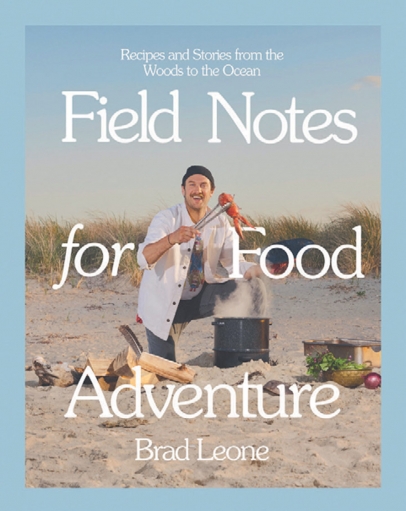Field Notes for Food Adventure
Recipes and Stories from the Woods to the Ocean
Review By Maria Buteux Reade
By Brad Leone | Photography by Pat O’Malley
Published by Voracious / Little, Brown and Company, 2021
Like any good piece of literature, a cookbook tells a story and reflects the author’s character. Brad Leone’s inaugural cookbook, Field Notes for Food Adventure, takes us on a rollicking ride as he explores, forages, cooks and eats his way through some of the most beautiful locations in the Northeast: Long Island Sound, the Delaware Water Gap, Catskills, coastal Maine, Vermont’s Lake Champlain and the rural hills of northern New Jersey. This book celebrates seasonal food and a life that embraces the outdoors, year-round.
Written in a non-fussy narrative style by an adventuresome chef, Leone draws the reader into his world of sustainably harvested, foraged and fermented foods. Brad fishes! He gathers! He grills! And then, he pulls dishes together in a joyful, swashbuckling fashion—and makes us feel confident we can do the same. No wonder the work was dubbed Food 52’s Best Cookbook of the Year.
The book is organized by the quintessential foods unique to each season and location Leone explores. His subtext of environmental conservation and ethical harvesting reminds us to gather and consume what’s abundant, local and sustainable. Along the coast of Maine, he harvests various seaweeds, which he dries and incorporates into dishes. A buddy swears him t secrecy and takes Brad to a favorite spot to forage ramps. “Fungus Friends” lead the chef on wild-mushroom forays around the Northeast. The last chapters on autumnal camping and outdoor cooking will have you reaching for a pack-basket and hiking boots.
Throughout the book, Leone provides tips about responsible foraging. For instance, wild mushrooms should be cut at soil level with a sharp knife so the complex root system can re-fruit. When harvesting ramps from public land, snip only the leaves and keep the deeply rooted bulb undisturbed in the soil to ensure the crop’s future. Conversely, the lifelong fisherman extols the virtues of squid (he actually devotes an entire chapter to this aquatic creature), which can be enjoyed freely, thanks to their abundance in our cold Atlantic waters. And when handlining for crab along the coast, skip the chicken and bait with native menhaden, aka bunker, part of the crustacean’s natural diet and environment.
Brad embraces the art and science of fermentation and offers inspiration for both dabblers and experienced pros. A refreshing watermelon drink infused with mint, basil and cayenne; thirst-quenching maple-chile switchel brewed from dark maple syrup, chiles and grated ginger; a Bloody Mary base of cherry tomatoes, horseradish root, garlic and za’atar. Follow Brad’s guidelines and you can ferment these libations at home. If you’re already parenting a sourdough Starter, try Brad’s herbed flatbread grilled or baked in cast-iron. Want to take summer stone fruits to the next level? Ferment your peaches, cherries and plums in salt and sugar for seven days with a little cinnamon, cardamom and a chile for kick and then throw them on the grill. Or consider making fermented mushroom-kombu shoyu, a Japanese soy sauce enhanced by shiitakes and kombu (dried kelp). After a week in the jar, the infused mushrooms can be sliced and used however you desire while the rich, salty, nutty soy sauce becomes even more of an umami bomb.
Brad served as Bon Appétit’s test kitchen manager, which explains his ability to tinker with tried and true recipes. Even a relatively common tomato and white bean salad gets new life sparked with white miso, cucumber chunks and toasted sunflower seeds. Into labneh (drained and thickened full-fat yogurt), Brad stirs mashed chickpeas, toasted almonds, honey and lemon juice for a perfect summer dip or spread. Smoked beef can be made in a smoker or in an oven. Rub a boneless roast with a blend of pepper, freshly ground coffee, powdered onion and garlic, cocoa, sugar, cayenne and olive oil. Roast low and slow for a couple of hours and then blast for a few minutes at 500 degrees to crisp up the exterior crust. Voilà—perfectly tender and deeply seasoned beef ready for slicing thin!
Leone notes in the introduction that “Cooking over live fire, experimenting with fermentation, foraging for and catching your own food all come with their own risks.” Yet the outdoorsman chef thrives on these Very risks! Just watch a few episodes of his It’s Alive video series from Bon Appétit. The 100-plus fast-paced and unscripted videos are hilarious, fueled by his stream-of- consciousness patter and exuberant, down-home personality. And that’s Brad’s message: Embrace life, make delicious food from local, seasonal ingredients, tell stories, and take care of the planet.




